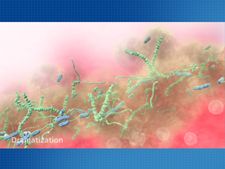The genome and gingivitis
March 3, 2009 | dentalproductsreport.com Web Exclusive Gingivitis and the genome A recent study uncovers just how complex gingivitis really is and may eventually lead to new treatment an
March 3, 2009 | dentalproductsreport.com
Web Exclusive
Gingivitis and the genome
A recent study uncovers just how complex gingivitis really is and may eventually lead to new treatment and prevention strategies.
by Noah Levine, Senior Editor

Gene chip technology was key to this study that helped identify the complexity of the human body's reaction to gingivitis.
Photo: Procter & Gamble Oral Care
It’s widespread in the U.S. population and a precursor to more serious issues such as periodontal disease, but the researchers behind a study published in the Dec. 2009 issue of the Journal of Periodontology were still surprised by how multi-faceted the body’s response to gingivitis is when looked at on a molecular level.
The study by the University of North Carolina at Chapel Hill and Procter & Gamble Oral Health found that close to one-third of the genes found in the human body are expressed differently during the course of an episode of gingivitis. The deeper understanding of how the body reacts to gingivitis is being examined as a part of the search for new ways to treat and prevent the disease and thus reduce the occurrence of the more severe gum diseases it can lead to.
“We always want to look for something that might be more effective, or might really change the game in terms of how we deal with gingivitis,” said Leslie Winston, DDS, PhD, Director of Professional and Scientific Relations at Procter & Gamble Oral Health. “We know from a microbiology point of view that if you kill plaque bacteria, or you inhibit plaque bacteria on the hard or soft tissues that in general people’s gum tissue gets healthier, but there are other mechanisms that we could be targeting.”
The study
The research subjects were all given a dental prophylaxis and put on a rigorous homecare regimen for two weeks. Then, through use of a mouthguard during homecare, gingivitis was induced in one portion of the subjects’ mouths via withdrawal of hygiene. Finally another dental prophylaxis was provided. Throughout the trial clinical plaque and gingivitis measurements were taken, along with biopsies of gum tissue that were used to look at the molecular activity taking place.
“This all points to the fact that resolution of inflammation is not simply the withdrawal of the stimulus of inflammation, it’s actually an active process that involves new genes being activated.”
-Dr. Steven Offenbacher
By using advanced genomics and bioinformatics tools, the research team was able to analyze the progression and resolution of gingivitis on a level never before seen. Lead author Steven Offenbacher, DDS, PhD, Director of the UNC School of Dentistry-based Center for Oral and Systemic Diseases, said the tools used can detect the activity of more than 30,000 genes and whether they are “upregulated” or “downregulated” during the different phases of gingivitis.
The study found more than 9,000 genes showed some activity and involvement in the gingivitis process. Some of the genes increased activity during the onset and decreased during the resolution, while others reversed that pattern. Others expressed a change only during one phase of the study, leading the researchers to be somewhat surprised by just how many different types of genes were involved.
“I believe it’s important from a clinical standpoint because it points not only to the complexity of the process, but it gives us new insight into how we might ultimately design new therapeutics,” Dr. Offenbacher said. “Most of our products to treat gingivitis are aimed towards the antimicrobial side of the formula. This mechanistic study enables us to identify many new potential targets that we could use as a site for anti-inflammatory points of intervention.”
While many studies have focused on more severe forms of periodontal disease that present more serious and immediate health concerns, Dr. Winston said it is important to study gingivitis because it often is the starting point for those more serious conditions. With an eye on being able to “intervene much earlier in the process,” she said the data from this study might help bring about a better understanding of how gum disease gets started, and how gingivitis progresses toward periodontal disease.
CONTINUED ON NEXT PAGE
{NEW_PAGE}
Surprising results

An illustration showing gingivitis bacteria.
Photo: Procter & Gamble Oral Care
As expected, changes were found in genes associated with the immune system, but the activity found in genes related to the healing of wounds, cell-to-cell communication and the involvement of neural pathways were all a surprise. Dr. Winston said that last group’s involvement shows just how different gingivitis is from other conditions.
“You don’t think about gingivitis causing enough of a disturbance that those neural pathways would be activated. Interesting enough, we don’t tend to see that on the genomics studies done of the more severe forms of gum disease,” she said.
For Dr. Offenbacher some of the most interesting results were the way different groups of genes were involved in the process at different times during the study. A deeper understanding of which genes are involved with just the onset of gingivitis and which ones activate during resolution can be keys to the design of new prevention tools and treatment efforts.
“This all points to the fact that resolution of inflammation is not simply the withdrawal of the stimulus of inflammation, it’s actually an active process that involves new genes being activated,” he said.
Using the data
A new focus on products that stimulate those anti-inflammatory processes could lead to improved preventive capabilities in dentifrices and mouthrinses, which Dr. Offenbacher described as “the first line of defense” against gingivitis. The deeper knowledge of the molecular process of gingivitis could also be used to develop highly effective treatments that he said might be in the form of topical applications.
More targeted anti-gingivitis products could come from this study, but Dr. Offenbacher said further research into the pathways involved in the transition from gingivitis to periodontal disease could have even more wide ranging benefits. Those links could start earlier than previously thought, Dr. Winston added.
With the oral-systemic link well established, stopping problems as early as possible is always important, and gingivitis is one of those starting points. Dr. Winston said today’s anti-gingivitis products are effective in most cases, but not all patients respond identically to the same treatments or care regimens. A better molecular understanding of the process could help dentists identify patients more prone to gingivitis or more serious gum disease through something as simple as a chairside saliva test.
With such knowledge in hand, Dr. Winston said it would be easier to keep a closer watch on the most at-risk patients and to find the treatment that works best for them. Knowing which genetic pathways play the key roles in the process, allows such focused and specific treatments.
“It really allows you to look at patients more specifically. You can come up with treatment modalities and even prevention modalities that are targeted to their unique needs versus using a one-size-fits-all approach, and that’s something of great interest to us,” she said. “We always want to look for something that might be more effective, or might really change the game in terms of how we deal with gingivitis.”
Noah Levine is a senior editor for DPR. Contact him at nlevine@advanstar.com.
Join the Discussion
- Comment on this and other articles on our Facebook page
Related Articles
- The DNA difference
- Help them make the connection
- Perio’s path
Related products
- Crest Pro-Health Rinse
- Triumph with Smart Guide Rechargeable Toothbrush
- UltraFloss Pre-Measured Dental Floss
ACTIVA BioACTIVE Bulk Flow Marks Pulpdent’s First Major Product Release in 4 Years
December 12th 2024Next-generation bulk-fill dental restorative raises the standard of care for bulk-fill procedures by providing natural remineralization support, while also overcoming current bulk-fill limitations.